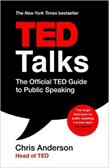It’s fair to say that most of us aren’t born with an innate ability to deliver impactful presentations – it’s a skill that needs to be practiced and mastered.
Whilst there are many training courses, books, articles and blogs out there to provide helpful tips and advice on how to deliver a successful presentation, I recently read “TED Talks: The Official TED Guide to Public Speaking” by Chris Anderson, the owner of TED. Given that TED Talks are often considered the ‘gold standard’ of public speaking, then the book provides a range of useful tools on how to give an impactful presentation, supported with lots of useful TED Talk examples to illustrate each tool.

Within this article, I’d like to share six of these tools for creating impact, so that your message is heard, remembered and can inspire action.
-
Start with an idea
It may sound obvious, but the first thing to think about is whether or not you have something of value to share with your audience – which is your priority focus beyond the charisma or presentation style you employ to share this idea. Anderson suggests that we should think of our idea as a valuable gift we’re sharing with our audience – something that can enrich their lives or thinking in some way, rather than something which might be more of a self-indulgent “bragging” exercise to the speaker!
Once you have decided on something meaningful you can share, then your goal is to recreate this idea in the minds of your audience and the tool at your disposal here, is the language you use. The key is to take your audience on a journey with you – starting from a very familiar place to a less familiar place. The way to do this is to start with language, concepts or assumptions that you know they can relate to. In this way, you can immediately have them join you on the journey without confusing, losing or isolating them at the start. You can then move them along through exploration or explanation to the newer idea or concept that you want them to know or think about.
-
The Throughline
Tied to the conveying of your idea, Anderson also talks about ‘The Throughline’. Whilst you can have beautifully-crafted slides and a charismatic way of presenting, if there’s no real takeaway, then all you’ve achieved at best is to entertain your audience. It’s therefore important to plan your presentation and think about the throughline; the connecting theme that ties together every element of your talk.
Some of the most successful TED talks use a throughline at the start to inform an audience of the idea they will be talking about. This is an effective tool since if you want an audience to come with you on a journey, then you should offer them a hint of where you’re taking them. However, this cannot be vague or boring – it needs an angle to it that can build intrigue. When thinking about this and about what can really hook your audience, the key is to think about what your audience cares about at a given point in time – again, so as not to alienate, bore or confuse them.
-
Structure
One of the most highly viewed TED speakers is Sir Ken Robinson, a British author and speaker on education in the arts. Having delivered a number of very successful talks, he shares his winning formula for success in the book, which is based around how your presentation is structured. Robinson claims that all of his talks follow a simple structure which is the same as any good essay in that they answer three important questions:
- What?
- So what?
- Now what?
To put this into context, your talk should do the following:
What?
Start with an introduction that sets the scene and captures the audience’s attention.
So what?
Move through to context – outline why this issue or idea matters to you and to your audience, sharing the main concepts or findings.
Now what?
Share the practical implications of these findings and conclude your talk.
-
Stories
There’s nothing that more naturally captures human interest and attention than a great story. This is something which has been evidenced for thousands of years – from the days when our hunter-gatherer ancestors sat around camp fires and shared stories. It’s the reason why films, television and novels are so popular! Stories evoke emotions and make you care about the outcome. However, there are three fundamental principles which should be applied to telling any story, for the greatest impact.
- The build-up
All good stories need to build tension, curiosity or suspense – ideally centred on a character the audience can identify, empathise and connect with. This could well be a personal story involving the speaker themselves – as long as you remember (as pointed out earlier) that everything you share with your audience should a gift to them; something which provides them with a valuable takeaway, lesson or learning.
- The detail balance
It’s also crucial to share the right amount of detail in any story you share. Adding descriptions of a particular scene or moments or emotions leading up to an event are useful if they help to build interest, tension and curiosity. However, adding too much can have the adverse effect – actually diluting the key moments of your story and potentially confusing and losing an audience along the way.
- The resolution
Your story also needs to end with a resolution. This can be a final reveal or a call to action for the audience. However, this should be delivered in a way which doesn’t insult the intelligence of your audience, meaning you shouldn’t force-feed a conclusion but allow them the chance to connect some of the dots for themselves.
- The build-up
-
Persuasion
Persuasion is about convincing an audience that the way they see the world isn’t quite right. This is different to an explanation as you’re effectively challenging how they might already think about something. Anderson suggests that before you construct your persuasive argument or viewpoint, then you need to first demolish the existing views your audience holds through “priming”. The human mind needs to be primed with examples which challenge its existing views. These help a presenter to gradually build their case, where stories or anecdotes supported with “real world” facts or statistics can give your argument added weight.
As an example, Anderson describes a TED Talk by Barry Schwartz who uses his presentation to argue the point that too much choice makes people unhappy. In taking the audience on a journey, he primes the audience with a personal anecdote of a frustrating shopping experience where too much choice was clearly a nuisance:
“There was a time when jeans came in one flavor, and you bought them, and they fit like crap, they were really uncomfortable, but if you wore them and washed them enough times, they started to feel OK. I went to replace my jeans after years of wearing these old ones, and I said, “I want a pair of jeans. Here’s my size.” And the shopkeeper said, “Do you want slim fit, easy fit, relaxed fit? You want button fly or zipper fly? You want stonewashed or acid-washed? Do you want them distressed? You want boot cut, tapered, blah blah blah.”
Priming your audience with such examples nudges them step-by-step in the right direction of where you’re going with your argument, making the new view you’re sharing more plausible for when you actually introduce it!
-
The Close
Last but not least, the final tip in delivering an impactful presentation is to pay attention to how you close. Don’t end flat! If the close isn’t memorable, then there’s a good chance your presentation won’t be. You should put as much effort and thought into how you close your presentation as you do into the presentation body itself. Don’t let this fizzle out with an obvious ending or a cliché such as saying something along the lines of “So, in conclusion…” or “That’s my final slide – do you have any questions?” etc.
Instead, try one of the following instead:
- A call to action
Invite a call to action at the end – nudging your audience to act on the ideas you’ve just shared for themselves.
- Future visions or goals
Finish by describing what an inspiring future could look like – a vision linked to what you have been talking about.
- A surprising question
End with a surprising question to get your audience thinking and which finishes your presentation with a moment of insight or closure – for instance, challenging the way your audience thinks or behaves.
- Use a narrative loop
Add in a conclusion that ties in very neatly to the opening of your talk.
- A call to action
As mentioned at the start of this article, most of us aren’t born with an innate ability to deliver impactful presentations. However, these tried and tested tools suggest that with some careful thought and planning, we can all learn from those that have mastered this skill to create memorable and inspiring moments on stage!
Readers of this article also viewed:


